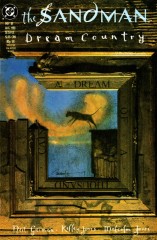Issue 18: "A Dream of a Thousand Cats"
Neil Gaiman, Kelley Jones, and Malcolm Jones III
- Second story in anthology, Dream Country
- Second story reprinted in trade paperback Dream Country
- Audible Act I Chapter 18
- Netflix Episode (first half)
Page 10#
Panel 1
"Carrion Kind" is evidently poetic nomenclature for scavengers (specifically crows?). See below.
Panel 3
Note that (as identified on page 14 panel 2) this is a crow and not a raven. Evidently bird-snots can tell the difference. Therefore, this creature is neither Matthew nor any other of the series of raven aides to Dream (who dwell with Eve, the Raven Woman).
Page 13#
Panel 1
The entrance to the Dreaming has been seen before to be guarded by a griffon, wyvern, and hippogriff. Here, the griffon looks more like a large vulture.
Page 14#
Panel 2
Dream appears to the viewer in a form that conforms to the viewer's expectations. Thus, he, as adversary, appears as a great panther, black, because that is Dream's color.
We may draw some conclusions from Dream's appearance. The final page of the story clearly establishes our time frame as post-1950 or so. Now, Dream was imprisoned from 1916 to 1987 or so, so we may conclude that either the cat has done an impressive amount of traveling (page 21) in the last several years, or the cat is more than seventy years old. The latter is not entirely impossible, given the messianic nature of the cat. Alternatively, given the revelations in Sandman #40 about the soft nature of time, the cat may simply have entered the Dreaming at a non-contemporaneous point, encountering a past or future Dream instead of a Dream who was imprisoned at the cat's time.
Panel 5
A cat may look at a king: Cleveland Amory's book, The Cat Who Came for Christmas has an extensive section on the origins of this proverb, from which I quote:
In the fifteenth century, the story goes, Maximilian I, of the House of Hapsburg, King of the Romans and soon to be Holy Roman Emperor, was deep in conversation with a friend of his named Hieronymus Resch, a maker of woodcuts. During this conversation, the king looked over and saw Resch's cat, stretched out on a table, staring not at Resch but at him. From this rather less than earth- shaking occurrence came, apparently, not only the actual proof of the proverb but also its rather less than happy future connotation - at least as far as kings are concerned. For Maximilian, who spent a good deal of his reign embroiled in turmoil, intrigue, and warfare, always declared that the cat had looked at him, with, as he put it, "deep suspicion" - a comment which, once again, will come as small surprise to all the cat-owned, before Maximilian's time, and since. And, years later the cat and the king confrontation became the basis for one of the famous "Fantastic Fables" of none other than the late Ambrose Bierce:
A Cat was looking at a King as permitted by the proverb.
"Well," said the monarch, observing her inspection of the royal person, "how do you like me?"
"I can imagine a King," said the Cat, "whom I should like better."
"For example?"
"The King of Mice."We may note that the proverb also makes an appearance in Alice's Adventures in Wonderland when Alice mentions it to the King of Hearts, but herself notes than she read it somewhere. Checking Bartlett's Familiar Quotations, we note the following:
"A cat may looke on a King." - John Heywood (1497-1580)
Proverbes, Part II, Cap. V
Page 17#
Panel 1-2
In early editions, the male was not not coloured with golden-hair. This appears to have been fixed in later versions.
Panel 2,4
The idea of dreaming to change the world is at least as old as Ursula K. LeGuin's The Lathe of Heaven.
Page 20#
Panel 4
Note again the reference to the Carrion Kind. This is reminiscent of the Red King in Through the Looking Glass, whose dreams might have been all of reality. We also see multiple layering of dreams here.
Page 23#
Panel 2
The corollary to Alan Moore's famous "This is an imaginary story. Aren't they all?" is this: All stories are also true.
Credits
- Originally collated and edited by Greg Morrow.
- Bill "Bad Company" Sherman sherman@math.ucla.edu did the literary antecedent thing in suggesting Kipling and LeGuin as inspiration, and later asked that the Kipling refs be removed as inaccurate.
- David Waterman Hyatt hyatt@owlnet.rice.edu delved into Cleveland Amory for information on cats and kings.
- Abhijit Khale (khale@alydar.Eng.Sun.COM) came up with the Alice reference and e elizabeth bartley (eeb1@ellis.uchicago.edu) bested him with the Bartlett's (boy, that must smart!). Colonel G. L. Sicherman
- (gls@cbnewsh.cb.att.com) also cited John Heywood.
- Tanaqui C. Weaver (cen@vax.oxford.ac.uk) and Neil Gaiman rambled on about the nature of the skeletal crow, which the Colonel also corrected me on.
- Tanaqui also located the carrionkind references.
- Ralf Hildebrandt added a comment about the gryphon's appearance
Last modified by Richard Munn on 2023-08-17 - Fixed names of guardians, and fixed some formatting
[edit this page] [page history]






